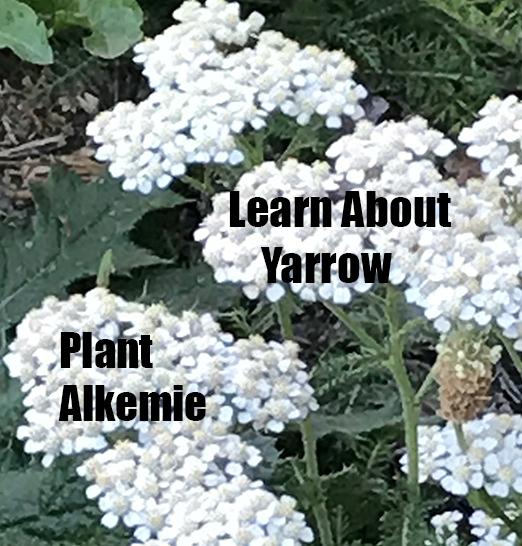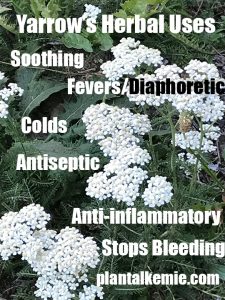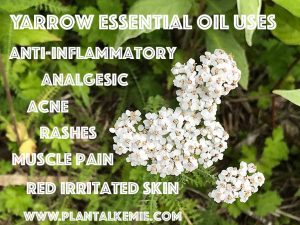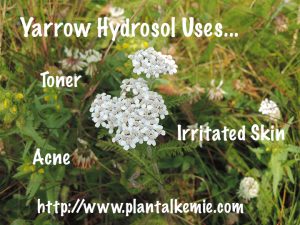Alaska (and Seattle) Plant #1: Yarrow

I just came back from a wonderful trip to Seattle, Alaska, and Victoria Canada. So I wanted to share some of my plant adventures with everyone. Most of the plants I saw were in Alaska, though a few were also in Seattle. The first plant I will discuss is yarrow.
I saw a lot of yarrow in my journey in both Seattle and in a few places in Alaska. I kept seeing this plant over and over again: it kept grabbing my attention! Yarrow is a wonderful herb well known to most herbalists, and I also use its essential oil and hydrosol. The essential oil and hydrosol are not as well known as the herb.
So I decided to share some of the photos I took of this plant, and some information I have learned about yarrow over the years. I only saw the actual plant/herb in my travels but I will post a little about its essential oil and hydrosol too since I have used them all.
Note: This is not a full complete herbal or aromatherapy profile, but only contains a few facts about the herb, essential oil, and hydrosol.
Latin Name:
Achillea millefolium and in Alaska it is Achillea borealis (Biggs, 1999/2016). Synonyms for Achillea borealis are Achillea millefolium var. borealis and Achillea millefolium ssp. borealis (USDA NRCS, 2018).
Plant Family:
Asteraceae
About The Plant:
You will typically find yarrow growing near roads, moist meadows, dry meadows, and open areas (Biggs, 1999, 2016). The flowers range in color; they can be white, deep pink, or red in the local rainforest (Biggs, 1999, 2016).
I have only ever seen the white ones; all of the ones I saw during my trip were white.
Herbalism–Herb:
In herbalism we use the flowers as well as the leaves, depending on what we are using it for. Some herbalists use the roots too.
Some of the uses for yarrow (as an herb) are for colds, fevers (it is a diaphoretic), as an anti-inflammatory, it’s soothing, to stop bleeding, and as an antiseptic. For some issues I may make an infusion (strong medicinal tea) or a tincture (alcohol + water extraction). It can be used as a poultice too.
For minor cuts and wounds (for bleeding and to kill the germs), herbalism legend Rosemary Gladstar (2001, 2008) recommends using the dried, powdered leaf.
Aromatherapy–Essential Oil And Hydrosol:
Yarrow essential oil is distilled from the flowers and leaves, and it is often blue, due to its azulene content. It is used as a strong anti-inflammatory and an analgesic. I have used it for muscular pain, and for skin issues, such as acne, rashes or other red and irritated skin conditions.
Essential oil safety expert Robert Tisserand (2014) mentions there are some drug interactions for its essential oil. He also recommends a maximum dermal use level of 8.6%.
I just wanted to clarify about max dermal concentrations since many people mistakenly believe that the suggested maximum dermal use level is the concentration that is always used in aromatherapy, instead of realizing it is the suggested maximum amount that can be safely used.
Usually for facial care I suggest using 1/2 to 1% total concentration of essential oils. For full body application, it is generally suggested that a 2% total concentration is used for a healthy adult. However, there are times that we (qualified professional aromatherapists) may use higher concentrations for small areas or spot treatments for specific issues. And in those cases you can use up to 8.6% of yarrow essential oil, if it is needed, for short term use. Much of the time that high of a concentration will not be needed but just mentioning that Tisserand does not recommend using more than 8.6% for safety reasons (for the times you need to use a higher concentration). He calculated the percentage based on the thujone, which may vary for each batch.
For more about percent concentrations, see my general and max dermal concentration article.
We also use the hydrosol in aromatherapy. It is an excellent toner for many skin types, including irritated skin. I have also used the hydrosol as part of a skin care regiment in cases of acne.
Catty (2001) states that the hydrosol smells like puppy breath.
The hydrosol has a unique aroma but I do not think it smells like that, and the scent does not bother me at all. However some people do not enjoy its aroma, so I recommend buying small amounts (like 1 oz) before investing in larger sizes to make sure you like its aroma.
References:
Biggs, Carol R. 1999 (originally written) and 2016 (8th printing). Wild Edible & Medicinal Plants: Alaska, Canada & Pacific Northwest Rainforest, Volume 1 An Introductory Pocket Trail Guide. Yarrow profile. p. 74.
Catty, Suzzane. 2001. Hydrosols–The Next Aromatherapy. Achillea millefolium/Yarrow profile. Inner Traditions/Bear & Company. Rochester, Vermont. Kindle Locations 2318-2319.
Gladstar, Rosemary. 2001 and 2008. Rosemary Gladstar’s Herbal Recipes for Vibrant Health: 175 Teas, Tonics, Oils, Salves, Tinctures, and Other Natural Remedies for the Entire Family. Yarrow (Achillea millefolium) profile. Storey Publishing, LLC. North Adams, MA. p. 372.
Tisserand, Robert and Rodney Young. 2014. Essential Oil Safety: A Guide For Health Care Professionals, 2nd edition: Yarrow profile. Churchill Livingstone/Elsevier. London, New York, and Philadelphia. p. 475-476.
United States Department of Agriculture, Natural Resources Conservation Service (USDA NRCS). 2018. Plants Profile for Achillea millefolium borealis (boreal yarrow). Accessed on August 1, 2018 at https://plants.usda.gov/core/profile?symbol=acmib
Alaskan Plant Articles:
Fireweed: https://www.plantalkemie.com/aromatherapy/alaskan-plant-2-fireweed/
Resources: For more information or if you have questions about aromatherapy, herbalism, formulation, perfumery, and eco living, please join Plant Alkemie’s Facebook group and Plant Alkemie’s Facebook business page. And check out more articles on Plant Alkemie’s website: https://www.plantalkemie.com. You may also leave questions about yarrow in the comments of this article.




Do you have a newsletter?
Hi Lor, thanks for your question! Currently I don’t have a newsletter but once I start teaching courses next year (in early 2019), I will be creating a newsletter. Right now the best way to keep up to date on my work and Plant Alkemie is to like my facebook page or join my facebook fan page. Have a wonderful day! https://www.facebook.com/groups/plantalkemie/
https://www.facebook.com/groups/plantalkemie/